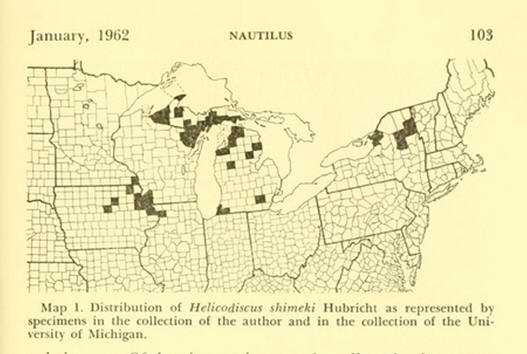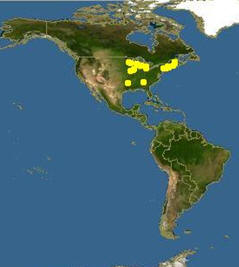
Habitat
Great Plains and coniferous forest habitats
show the most favorable living conditions for North American land
snails while tundra, taiga, short grass prairie, and desert habitats show
unfavorable living conditions (Solem, 1984).
Some species of land snails can still be found in unfavorable
habitats, but the amount of species living there is significantly
less than the species in favorable habitats.
Helicodiscus shimeki is primarily found in forest
habitats. Most land snails that live in forest habitats live among
low plant, leaf litter, or woody debris in the upper soil horizon (Hotopp,
2002).
 The
genus Helicodiscus has a vast range of dispersal in North America
found in areas of Mexico expanding all the way up to Canada.
Some species of Helicodiscus are even found in the islands of
Cuba and Jamaica (Pilsbry, 1998).
Helicodiscus shimeki
is native to southern parts of Canada (Grimm,
2009) and spans down to Iowa (Poweshiek
skipper project, 2005).
See Figure 1.
The
genus Helicodiscus has a vast range of dispersal in North America
found in areas of Mexico expanding all the way up to Canada.
Some species of Helicodiscus are even found in the islands of
Cuba and Jamaica (Pilsbry, 1998).
Helicodiscus shimeki
is native to southern parts of Canada (Grimm,
2009) and spans down to Iowa (Poweshiek
skipper project, 2005).
See Figure 1.
Figure 1. Distribution map of Helicodiscus shimeki
in 1962 (Hubricht,
1962). (Canada not shown)
The distribution of Helicodiscus shimeki has been updated since 1962 finding the snail in north eastern states including Maine (Martin, 2000) and in southern states like Kentucky (Nature Serve Explorer, 2009). These new locations might be due to the snail migrating into new areas. However, Helicodiscus shimeki is not a common land snail and is relatively small; the snail could have been easily overlooked in those areas in previous years. See Figure 2.
Helicodiscus shimeki in 2011.
